
A Russian satellite, the RESURS-P1, broke apart in low Earth orbit on June 26, creating over 100 pieces of trackable debris. The event occurred near the International Space Station (ISS), prompting astronauts to take shelter for approximately an hour as a precautionary measure.
The RESURS-P1 satellite was launched in 2013 and weighed around 13,200 pounds (6,000 kilograms). It was in a nearly circular orbit at an altitude of 220 miles (355 kilometers) above Earth when it disintegrated. The cause of the break-up remains unclear, with speculation suggesting it may have been due to a small impact or an explosion of an onboard battery, or possibly the result of an anti-missile test.
The ISS crew was ordered to seek shelter as a precautionary measure while mission control assessed the risk of collision with the debris. After about an hour, they were given the all-clear to exit their spacecraft and resume normal operations.
The incident highlights the growing issue of space debris in low Earth orbit, which poses a potential threat to both manned and unmanned spacecraft. NASA estimates that there are over 25,000 pieces of debris wider than four inches in orbit around Earth, with the number increasing to over 100 million when smaller objects are taken into account.
The RESURS-P1 satellite was a Russian Earth observation satellite that had been decommissioned in 2022. Its sudden disintegration serves as a reminder of the importance of responsible space debris disposal and the need for continued efforts to mitigate the risks associated with space debris.


